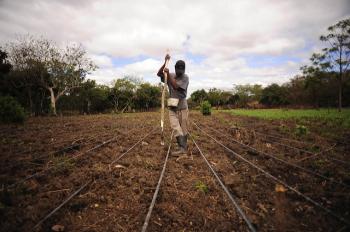Small farmers face pretty much the same issues no matter what part of the world they happen to till -- access to land, seed, financing and more.
I learned that lesson while rolling through the hills of northern Nicaragua, acting as an interpreter for a brigade of Canadian farmers hoping to transfer their skills to support local farmers. At that time mechanization for many small farmers in Nicaragua seemed to be the main impediment. But thinking back to the exchanges I translated, the lack of tractors, chemicals and artificial fertilizers presented challenges but also possibilities to explore.
How do you grow food in a world where resources are limited? For small farmers in developing regions, resources have always been limited. These Canadian and Nicaraguan farmers wanted to learn from each other, and the challenges each group faced related to producing food, farming methods, and taking care of the soil and their communities. The question was how best to do this in a global system based on profit and not on stewardship. At the end of the brigade's stay, it would be fair to say that the Canadians learned as much if not more than their Nicaraguan counterparts. Both realized that the problems facing agriculture were much larger than farmers themselves. Still, they persevered.
These progressive farmers knew that agriculture could be part of the solution -- for community, health, food security and much more.
Agriculture and climate change
Despite the attempts of certain farm groups, for many years agricultural practices in so-called developed nations have been environmentally destructive. We have been told that the industrial model of agriculture is necessary to ensure production and food security. It's an old story, one that has created a false reality. And the North has promoted that false reality. Aid programs targetting developing nations have long tried to transfer the industrialized model to smaller, poorer countries. Industrial agriculture has been supported as the only model that is successful. The costs have been huge.
The time has come to look at how agriculture might actually be a huge part of climate change mitigation.
Agriculture can reduce greenhouse gas emissions, but it is going to mean putting stewardship and food production ahead of profit and expansion. It is possible.
In the '70s and '80s we were told that organic farming was impossible, that crops would be lost to weeds, that a farmer would go bankrupt, that people would end up starving -- that organic farming was just not possible. Now huge corporations are trying to sell us organic food produced on the other side of the planet. Parts of the organic model have been conveniently skipped -- the part about local production for social, economic and environmental reasons. Essentially the agroecological principles of organic farming are removed when it becomes based on imported food and corporate farming. These are the same practices that increase greenhouse gas emissions as opposed to reducing them.
These days terms like carbon sequestration, biodynamic agriculture, Demeter farming, holistic management, regenerative agriculture, perennial polyculture, and permaculture are entering the ag lexicon -- phrases that are all related to practices consistent with agroecology that link agriculture and climate change.
A sustainable model of agriculture
Agroecology goes a step beyond organic farming, in that it urges support for low-input, small farms that encourage systemic change toward sustainability. It is about promoting agricultural practices that bring together economic, environmental and social or community factors. It is about bringing together those who consume food and those who produce it to ensure sustainable practices. In effect, it is about adopting a system of agriculture that meets many goals, including mitigating climate change.
Annual carbon emissions from global agriculture can be reduced by between 50 and 90 per cent by 2030 by changing cultivation practices, intensifying crop and livestock production, and reducing food waste. The Food and Agriculture Organization has concluded that one-third of food produced is wasted either through crops that do not get to market, or in handling and storage, processing, packaging and distribution, or wasted during consumption.
Mitigating climate change through agricultural practices can be so much more than reducing the use of fossil fuels or eliminating the use of artificial pesticides and fertilizers, though these actions are also crucial. Carbon sequestration is a form of agriculture that lowers the carbon footprint in farming practices. Preservation of soil carbon is key to agricultural productivity because it reduces erosion, and increases soil fertility and moisture retention. And sequestering carbon in agricultural systems can be part of the climate solution. In the end though, mitigation is about how you grow and produce food. Recent studies are showing that even raising cattle, considered to have a huge carbon footprint, can actually help mitigate climate change if herds are sized appropriately and grass-fed.
Agroecology brings farmers and consumers closer together, because while it is about the environment and food systems, it is also about an appropriate diet. For example, while you may eat beef, it is how about how much beef you eat and about how that beef was produced. Agroecology does not support huge feedlots and slaughterhouses, and it most certainly does not support "super-sized" portions of meat.
Movements for change
There is a growing movement advocating for the protection and support of small farmers in developing countries as a way of implementing sustainable development goals. Many Canadian aid groups, for example, note that Canada's development goals regarding gender and poverty can be met if aid supports small-scale agriculture.
Across Latin America landless peasant movements are learning about and implementing agroecology, a practice promoted by La Via Campesina and the small farmers it represents. And increasingly in Canada we have a generation of new agrarians, many of then millennials, keen on farming ecologically and building community, as documented in a recent article I wrote for the UC Observer.
Thinking about those Canadian and Nicaraguan farmers back in the day and the moves toward agroecology today has reminded me that our agricultural policy should work in tandem with our aid policy. It can no longer be about "us" and "them" if it ever was, because thinking globally and acting locally just makes sense. And what we wish for others we should also wish for ourselves.
That means huge efforts need to be made now to create policies that invest in agriculture in Canada and in programs we support internationally -- policies that link food production and small land holdings, and that mitigate climate change. Creative policies build healthy communities and are open to practices that help solve problems rather than continuously create them.
Yes -- it is 2017 and high time to get with the program. The planet needs us to get it right and time is a-wasting.
Lois Ross is a communications specialist, writer, and editor, living in Ottawa. Her column "At the farm gate" discusses issues that are key to food production here in Canada as well as internationally.
Photo: CIAT/flickr



Comments
Do
Don't